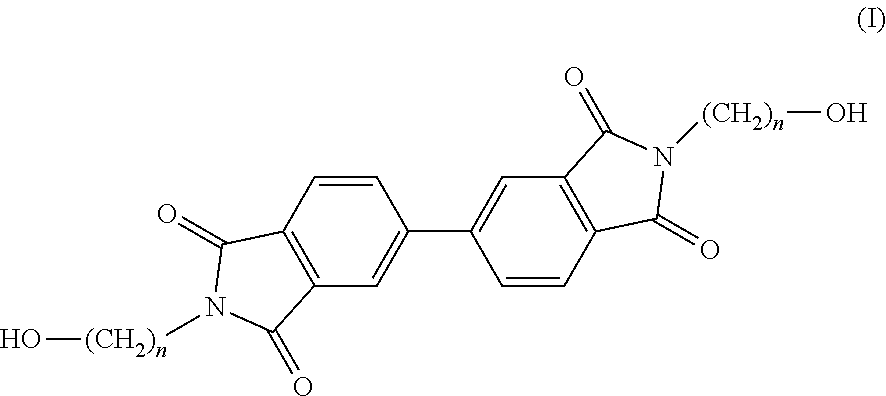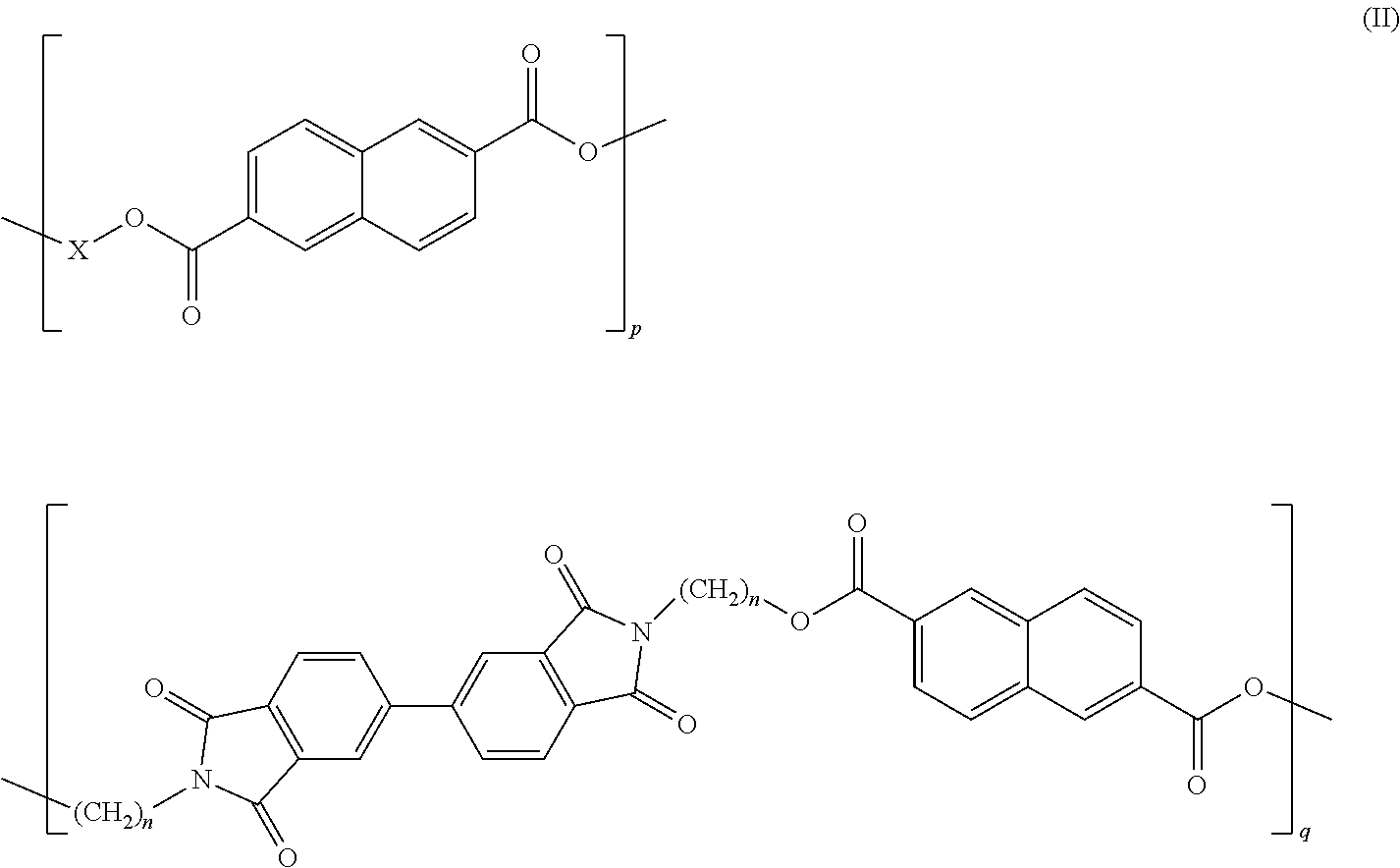Copolyesterimides of poly(alkylene naphthalate)s having high glass transition temperature and film made therefrom
a technology of alkylene naphthalate and copolymer, which is applied in the field of new polyesters and films made therefrom, can solve the problems of high tg, high tg, and high tg, and achieve high or increased tg, improve heat resistance and thermomechanical stability, and improve tg.
- Summary
- Abstract
- Description
- Claims
- Application Information
AI Technical Summary
Benefits of technology
Problems solved by technology
Method used
Image
Examples
example 1
Synthesis of N,N′-bis-(2-hydroxyethyl)-4,4′-biphthalimide (Monomer 1)
[0073]
[0074]4,4′-biphthalic dianhydride (5.65 g, 19.20 mmol), ethanolamine (2.4 ml, 39.37 mmol), DMAc (40 ml) and toluene (35 ml) were charged to a 250 ml round bottom flask and heated to 130° C. overnight. Dean-Stark apparatus was used to azeotropically distill off the water by-product. The hot reaction mixture was then added to water (˜400 ml) upon which a white precipitate formed. This was then stirred for 6 hours, filtered, washed with water (2×40 ml) and MeOH (2×40 ml) and dried in a vacuum oven at 100° C. overnight. Residual solvent was removed as the product was boiled in water (40 ml) for 4 hours then filtered hot, washed with MeOH (2×25 ml), filtered and dried in a vacuum oven at 80° C. overnight. The isolated product was a white powder. (6.21 g, 81%), m.p. (DSC) 286° C., 1H NMR (400 MHz, DMSO) δ (ppm) 8.22 (m, 4Hb+c), 7.97 (d, J=8.16 Hz, 2Ha), 4.85 (t, J=11.96 Hz, 2Hf), 3.67 (t, J=11.28 Hz, 4Hd), 3.59 (m,...
example 2
Synthesis of a Copolymer of PEN Containing 5 mol % of Monomer 1
[0075]Bis-(2-hydroxyethyl)-2,6-naphthalate (4.7498 g, 15.62 mmol), N,N′-bis-(2-hydroxyethyl)-4,4′-biphthalimide (0.3128 g, 0.82 mmol) and GeO2 (5.2 mg, 0.04 mmol) were charged to a Schlenk tube fitted with a rubber sealed stirrer guide and a glass stirrer rod. The reaction mixture was heated to 200° C. over 30 minutes by use of a tube furnace under an inert nitrogen atmosphere. A vacuum of 2.8 torr was gradually applied over 1-2 minutes and a stirring rate of 300 rpm was applied via a mechanical stirrer and the reaction mixture was heated to 300° C. over 10 min. This temperature was maintained for 1.5 hours when the melt became increasingly more viscous. After this time nitrogen was purged through the system, the stirrer was removed and the mixture was allowed to cool. The reaction tube was cut and the glass tubing containing the polymer was broken up. The polymer was dissolved away from the glass and the stirrer in a so...
example 3
Synthesis of a Copolymer of PEN Containing 10 mol % of Monomer 1
[0076]Bis-(2-hydroxyethyl)-2,6-naphthalate (4.5012 g, 14.79 mmol), N,N′-bis-(2-hydroxyethyl)-4,4′-biphthalimide (0.6253 g, 1.64 mmol) and GeO2 (5.5 mg, 0.04 mmol) were charged to a Schlenk tube fitted with a rubber sealed stirrer guide and a glass stirrer rod. The reaction mixture was heated to 200° C. over 30 minutes by use of a tube furnace under an inert nitrogen atmosphere. A vacuum of 3.3 torr was gradually applied over 1-2 minutes and a stirring rate of 300 rpm was applied via a mechanical stirrer and the reaction mixture was heated to 300° C. over 10 min. This temperature was maintained for 1.5 hours where the melt became increasingly more viscous. After this time nitrogen was purged through the system, the stirrer was removed and the mixture was allowed to cool. The reaction tube was cut and the glass tubing containing the polymer was broken up. The polymer was dissolved away from the glass and the stirrer in a ...
PUM
| Property | Measurement | Unit |
|---|---|---|
| decomposition temperature | aaaaa | aaaaa |
| Tm | aaaaa | aaaaa |
| Tg | aaaaa | aaaaa |
Abstract
Description
Claims
Application Information
 Login to View More
Login to View More - R&D
- Intellectual Property
- Life Sciences
- Materials
- Tech Scout
- Unparalleled Data Quality
- Higher Quality Content
- 60% Fewer Hallucinations
Browse by: Latest US Patents, China's latest patents, Technical Efficacy Thesaurus, Application Domain, Technology Topic, Popular Technical Reports.
© 2025 PatSnap. All rights reserved.Legal|Privacy policy|Modern Slavery Act Transparency Statement|Sitemap|About US| Contact US: help@patsnap.com



